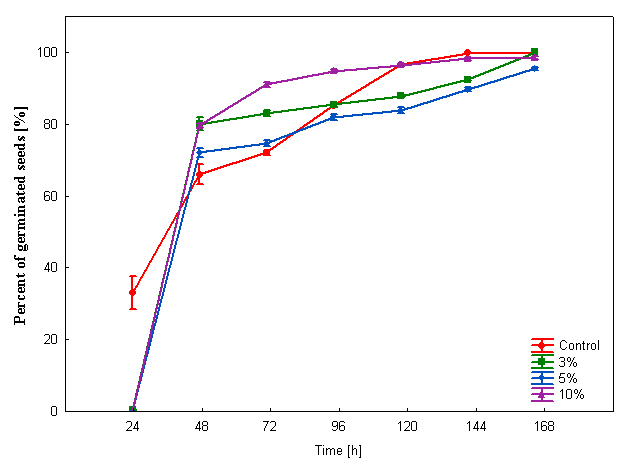The morphological changes of Phaseolus vulgaris L. exposed to the aqueous extracts of the leaves of Juglans regia L.
Abstract
To date the allelopathic interactions between plants didn’t explained, whether some substances are produced by plants to counteract competition or these substances are randomly generated and they are transferred from generation to generation. For that reason an attempt was made to investigate the influence of the aqueous extracts of dried leaves of walnut (Juglans regia L.) at concentrations of 3, 5 and 10% on the germination, growth, weight and morphology of bean (Phaseolus vulgaris L. cv. Laurina). The results indicate that increasing concentration of extract has a stimulating effect on seeds germination in comparison to the control. Extracts at a concentration of 3% and 10% inhibited the growth of the majority of organs and caused reduction of their fresh and dry weight. Whereas the extract at a concentration of 5% stimulated plant growth.
References
Gniazdowska A., Oracz K., Bogatek R. 2004. Allelopatia-nowe interpretacje oddziaływań między roślinami. Kosmos – Problemy Nauk Biologicznych 52 (2): 207–217.
Grzesiuk S., Kulka K. 1981. Fizjologia i biochemia nasion. PWR i L.
Harborn J.B. 1997. Ekologia biochemiczna: 275–291. Wyd. PWN, Warszawa.
Kołodziejczyk-Nieckuła E. 1994. Allelopatia. Wiedza i Życie 10: 28–32.
Krupa J. 1970. Rola światła w procesie kiełkowania nasion i zarodników. Rocznik Naukowo Dydaktyczny WSP w Krakowie –Prace botaniczne II 39: 5–17.
Lewicki P. 2010. Kiełki nasion jako źródło cennych składników odżywczych. ŻYWNOŚĆ. Nauka. Technologia. Jakość 6 (73): 18–33.
Oleszek W., Głowniak K., Leszczyński B. 2001. Biochemiczne oddziaływania środowiska. Akademia Medyczna, Lublin.
Sobótka W. 1997. Alleloherbicydy – wczoraj i dziś. Postępy w ochronie roślin 37 (1): 50–57.
Widera M. 1994. Możliwości wykorzystania zjawiska allelopatii w ochronie roślin. Ochrona roślin 38 (9): 15–16.
Wójcik-Wojtkowiak D., Politycka B., Weyman‑Kaczmarkowa W. 1998. Allelopatia. Wyd. AR, Poznań.
Zhang H., Gao J.M., Liu W.T., Tang J.C., Zhang X.C., Jin Z.G., Xu Y.P., Shao M.A. 2008. Allelopathic substances from walnut (Juglans regia L.) leaves. Allelopathy J. 21 (2): 425–431.


This work is licensed under a Creative Commons Attribution-NonCommercial-NoDerivatives 4.0 International License.
The journal is licensed by Creative Commons under BY-NC-ND license. You are welcome and free to share (copy and redistribute the material in any medium or format) all the published materials. You may not use the material for commercial purposes. You must give appropriate credit to all published materials.
The journal allow the author(s) to hold the copyrights and to retain publishing rights without any restrictions. This is also indicated at the bottom of each article.





